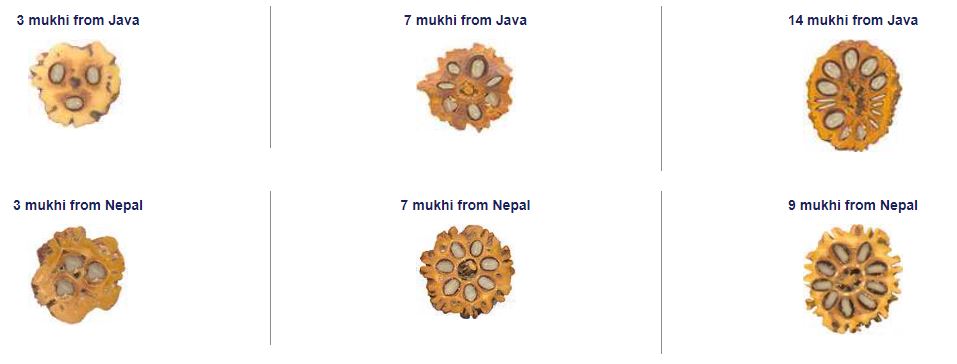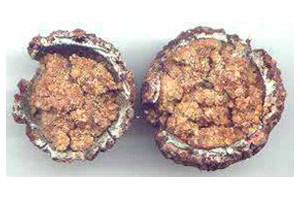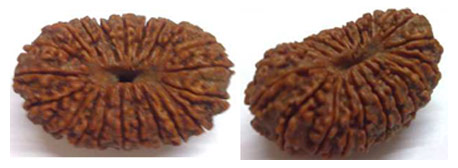FAKE RUDRAKSHA BEADS (CONSUMER INFORMATION)
Rudraksha is the most expensive and also the most smuggled seed in the world. Unscrupulous persons profit on the yearning of people to obtain rudraksha beads by selling large quantities of counterfeit beads in India and overseas. In the interest of consumer protection and public education, Rudra Centre reveals photographs and information regarding previously purchased and found fake beads.
Many people are purchasing not only man-made beads but also fake certificates.
Once you have seen an authentic bead and understood its structure, you will be able to easily identify a fake rudraksha. Recurrently, the most expensive mukhis which are the higher mukhis, are fakes. Certificates have no meaning because they are created by the seller. Be especially cautious when purchasing rudraksha beads ranging from 2 mukhi and below and 13 mukhi and above. If it sounds cheap, it is frequently fabricated by carving or cutting extra lines. For instance, 12 mukhi could easily become 14 mukhi by carving 2 extra lines and its price would grow 10 times. A bhadraksha variety bead is passed on as a Nepal bead in case of 2 mukhi. Gauri Shankar and Trijuti rudraksha beads which are naturally conjoined rudraksha are made by gluing lower mukhi rudraksha beads together. 1 mukhi is the most faked rudraksha as it is most sought after. If you type '1 mukhi' into Google, you will find many suppliers selling one mukhi Nepal bead in multiple shapes. The truth is that they are all fakes, as a genuine 1 mukhi rudraksha occurs only in Indonesia and is extremely tiny (9-12 mm) and is half elliptical in shape.
Though rudraksha mukhis are popularly associated with the 'lines' or 'grooves' of the beads, to distinguish amid the different varieties in today's market, it is important to associate the term mukhis with 'inner compartments' instead. For instance, 14 mukhi rudraksha is a natural rudraksha with 14 seeds encased in 14 compartments revealed by X-ray or by carefully examining the bead under high powered magnification. While the external surface can be altered by fakers, the internal structure cannot be. However this also needs an expert and experienced eye as the compartments many times are very close to each other and the seeds inside them are not visible. Note that even though the seeds could be too small or would have dried up, the bead functions fully. So it is the compartment that makes the mukhi line natural. Also it is important that the rudraksha bead has all the lines running end to end. If any line is partially formed and not a complete 100% line, the bead does not function properly. Rudra Centre ends up discarding 90% of the produce of Nepal and Java beads due to incomplete lines. Thus we always pick up the produce of the seasons first to have our choice beads.
Compartments are associated with the number of mukhis and lie beneath the mukhi line. Each compartment hold a seed which can be dried/not visible.

LABORATORY SERVICES
At present several private laboratories have sprung up across different cities in India claiming to authenticate Rudraksha beads. After examining their certificates, Rudra Centre found several gross errors. Beads having underdeveloped mukhi lines were certified at complete mukhis. Glued beads were certified as genuine. Beads that are not properly segmented as Trijuti were certified as the precious Trijuti. Beads that are broken from Savar were certified as genuine one mukhi. Artificially carved lined beads were certified as genuine. These laboratories give genuine certificates to the suppliers at an escalated price and now even they have started selling rudraksha and have become rudraksha suppliers due to the demand of their certified beads.
RUDRA CENTRE AUTHENTICATION SERVICE
Rudra Centre offers a free Authentication Service anytime there is a legitimate doubt regarding the authenticity of rudraksha beads obtained anywhere in the world. The interested person can accurately scan the beads from different angles at high quality resolution and submit the photographs to Rudra Centre in India. Please note that the email size should be not be more than 1 MB. If we require a more thorough examination, we would ask you to courier the beads to us for microscopic examination. Shipping charges to and from Rudra Centre are borne by the interested person in this case. Regardless of whether it is performed by picture scanning or physical analysis, this service is provided for free via: rrst@rudracentre.com.
COMMONLY FAKED 1 MUKHI IN THE MARKET
Rudra Centre does not sell round one mukhi from Nepal because it does not exist. Below are some of the type of fake one mukhis being sold in the rudraksha market. Sellers skilfully obliterate all but one line of four or five mukhi rudraksha. Sometimes a stem is glued to it to make it appear as a natural bead plucked from the tree.Sellers carve a line in an underdeveloped rudraksha bead. On seeing the X-Ray images of these beads, one can see very clearly that they have actually multiple compartments inside and not one. Again, it is imperative to associate “mukhis” with compartments rather than with the outer appearance on their surface.Many times seeds from other trees that are round in shape are carved with a line and a hole created in them to dupe the buyers. Several stories around them are created to mystify this bead and create a high value for it.
Nowdays the most commonly sold one mukhi is a broken piece from a natural Gauri Shankar rudraksha that has one mukhi as one of the bead. Such a conjoined bead is also called one mukhi Savar(Naag). This is not a genuine one mukhi rudraksha, but rather a broken Savar bead.
One mukhi beads that are available in half-moon cashew shape are not actually Rudraksha beads but produced instead by the Bhadraksha trees found in South India or Srilanka. Unfortunately, these beads are the most commonly “one mukhis” seen and sold widely in teleshopping included as if they were genuine rudraksha beads. Similarly most commonly sold 2 mukhi is a bhadraksha bead from South India or haridwar. Bhadraksha beads do not have any therapeutic value and Rudra Centre does not recommend these for any kind of healing therapy. They do not have a natural hole and the seed is right in the centre, unlike real rudraksha which have a hole in the centre and seeds just below the mukhi lines in different compartments. Moreover, they are neither from Indonesia nor Nepal as advertised.
CHINESE RUDRAKSHA GLOBAL EXPANSION
Chinese traders are using genetically (DNA) modified seeds to manipulate the production of rudraksha. They also use locks to alter the natural shape of the beads. As a result of these man-made interferences which are not in alignment with nature, Nepalese and Indonesian farms are being destroyed over time. Unfortunately, and moreover, they own their own plantations of Rudraksha trees, which are also native to China, without respecting the natural growth cycle of the trees' fruits, instead speeding up their production with damaging chemical compounds for the trees and harvesting immature fruits in a matter of months that normally require years to mature.
Since the past six years, the Chinese have shown a growing interest in rudraksha. They travel into the interiors of Nepal and Indonesia in search of uniform sized, large beads for use in jewellery. In order to sell jewellery and make a profit, they are marketing rudraksha beads as Buddhist prayer beads (bodhi beads) which have a long tradition in Chinese religion. They entice farmers with higher purchase prices and force them to use chemicals and hormones to stimulate the trees' production of enormous beads and clamp the fruits with gadgets while they are still on the tree in order to alter their shape to be flat in the mouth and the tail in order to meet their jewellery requirements. This has a negative impact on the growth of the trees and the natural production of mukhis. The same they do in recently established rudraksha farms in China by planting genetically engineered rudraksha seeds and damaging the development of the fruits with multiple forms of chemical compounds. The rudra beads from such treated trees lack a thorny structure and well-defined mukhi lines. They are also light weight and show a bundled appearance; subsequently, trees harmed in this manner produce fewer high mukhis and instead more 5 to 10 mukhis. When ripe, raw rudraksha fruits are a beautiful shade of blue, whereas Chinese-modified fruits are harvested while still green, indicating that they are unripe and lack proper inner development, in addition to the chemical alteration caused to them throughout their entire growing period. It is important to remember that real rudraksha has a unique composition in a very delicate balance of carbon, hydrogen, nitrogen and oxygen along with a specific chemical composition comprising alkaloids, flavonoids, fats, proteins, tannins and triperpenes among others. In addition, they contain rudrakine, a unique alkaloid discovered in 1979 which is only found in real rudraksha fruit. The properties of authentic rudraksha are adversely affected when their natural composition and biochemical balance is altered by dishonest merchants through the use of artificially induced chemicals in both the trees and the fruits.
Rudra Centre advises against purchasing these artificially altered beads and warns of their global market expansion by the Chinese. We recommend only acquiring rudraksha beads from reputable vendors with an extended market presence.
PICTURES OF FAKE RUDRAKSHA BEADS

This is 2 mukhi flat bead from South India available abundantly. The line at one end is left as it is and the other line is manually altered to carve a lingam, Nag and trishul. This is the most commonly sold fake one mukhi.

1 mukhi bought from Malaysia. It is nearly four inches in diameter and looks and feels like a rudraksha. However it is glued with Rudraksha pieces.
Fake 1 mukhi half-moon shape from China. It is commonly sold in market and dissolves on wearing and melts near heat. Surface is hard and not woody.

Fake One mukhis from Nepal with 'Om' ,'Trishul' & 'Shivling' carved on the top.
Fake 1 mukhi made by distortion of four lines in a five mukhi rudraksha . The x-ray shows that it is a 5 face rudraksha.


This is a seed with a skilfully carved line sold as a Rudraksha species bead. Can be detected by sight due to the presence of smooth scales on the bead which is unlike the thorny protrusions on rudraksha beads. Usually sold capped in gold or silver to avoid seeing the drilled hole of the seed. Studies are going on to determine the species of this bead. Purchased from a reputed ashram for Rs 11,500.

Most commonly sold variety. This is actually a 3 faced Oval bead of Indian origin and not Nepalese . Other lines are skilfully obliterated leaving only one line. Purchased from Haridwar for Rs 1100- Rs 3000. Can be identified by sight.

A commonly sold variety from Indonesia. In this small pieces of Rudraksha are glued on four of the lines of a five mukhi bead thus leaving only one deep line. Can be detected by dipping in hot water for 2-3 hours . The other hidden lines would show up in a different color as the glue softens. Pieces chip off on regular wearing . Purchased from Indonesia for $100.

Another very commonly sold variety . This is a giant ball like piece usually given a strong sandalwood odour. Small pieces of Rudraksha are glued on a seed and a line is carved externally. Sent by a client John chew of Singapore for verification purposes, which was purchased by him for $500 from a Himalayan monk. Has a natural stem implanted on top to give the 'look'. Pictures shows the outside view and the inner section after opening it. Filled with edible gum.

This is a synthetically manufactured bead sold as 1 mukhi in religious places of India by roadside hawkers. Pictures show top view and side view . Purchased for Rs 10 after bargaining . Can be detected by sight only.

This is a five faced Rudraksha bead in which all lines except one are hidden by sticking black glue. Pictures show two different views. Sold widely in India at road side hawkers in religious places. Can be detected by boiling in water and also by sight.

This has Om , Trishul and Snake head carved and glued on two mukhi Bhadraksha beads . Sold commonly as 1 mukhi all over India and abroad . Purchased from Shop outside Trayambekhwar Shrine in India for Rs 20. Pictures show two different designs having 1 hood and 3 hoods.
Below pictures are of underdeveloped 3 Mukhi and 5 Mukhi Rudrakshas which are having only one Mukhi on the outer surface. On seeing the X Ray pictures of these beads one can see very clearly that they have actually 3 or 5 seeds inside. These types of Rudrakshas are available in Nepal for around USD 45. Please note that these beads are absolutely natural and no tempering has been done with the bead, but these beads cannot be considered as Eka Mukhi Rudraksha because in X Ray pictures the seeds inside these beads are more than one. In some case it is 5 seeds and in some case it is 3 seeds.
Under Developed 1 Mukhi Rudraksha showing clear One Mukh. Under Developed 4 Mukhis and 1 complete Mukh can be seen.

Under Developed 1 Mukhi Rudraksha showing clear One Mukh. Picture showing starting of Mukhis with 1 clear Mukh of under developed bead.

Under Developed 1 Mukhi Rudraksha showing clear One mukhi. Picture showing starting of mukhi of under developed bead.

Under developed 1 Mukhi Rudraksha showing clear One mukhi. Under developed 2 Mukhis and 1 complete mukhi can be seen.

POPULAR METHOD OF CARVING EXTRA LINES ON BEADS:
It is common to carve additional lines in a lower mukhi bead to make a higher mukhi bead that costs more . The sharp unnatural lines are clearly visible for an experienced eye.
Identification is performed by checking for colour changes at carved line , cracked at the start and end of carved lines , and sharpness of line . A natural mukhi lines is slightly curved and not sharp , hence experienced suppliers are able to detect this.

Fake beads made by carving extra lines. Typically 6,7 mukhis are changed to 8-12 mukhis with this process. Or 12 mukhis are changed to 14 mukhis and more with this.

7 mukhi changed to 8 mukhi by carving 1 line.

6 mukhi changed to 8 mukhi by carving 3 extra lines. Notice the sharp carved

5 mukhi changed to 9 mukhi by carving 4 extra lines.

6 mukhi changed to 14 mukhi by carving extra lines

Fake bead made by gluing together sections of several genuine rudraksha beads of lower mukhis. Sold as 14 mukhi in Kathmandu city of Nepal.

Fake beads made by gluing together sections of several genuine rudraksha beads of lower mukhis. Sold as 21 mukhi in Kathmandu city of Nepal.

Fake bead made by joining together different sections of other rudraksha bead, to form one bead. Notice the central round small hole and the sharp mukhi lines, which clearly reveal it as fake. Sold as 21 mukhi.

Fake beads carved out of betel nut. Method commonly used to make high mukhi beads up to 21 mukhi. Purchased in 1998, Varanasi, India.

Fake Trijuti made from three Rudraksha beads ground and glued together. Purchased from Mumbai, India 1999.

Fake Gauri Shankars made from two Rudraksha beads ground and glued together. Purchased from Mumbai , India 1999 and Nasik in 2001.
Fake 20 and 21 Mukhi Rudraksha

Other fake mukhi Rudraksha & Rudraksha malas

Fake mala of 108 + 1, 2 mukhi beads. Purchased in 1999, Indonesia. Now widely sold all over India.

Fake mala of 108 + 1, 2 mukhi beads. Purchased in 1999, Indonesia. Now widely sold all over India.

Seeds of Ber tree which are coloured and sold as rudraksha beads mala Can be detected by sight as no mukhis are visible.

Fake mala of 108 + 1 mukhiless beads Purchased in 1988, Nepal.


-in-Astrology.jpg)






.jpg)

-Rudraksha-Beads---Thumbnail.jpg)


Comments 0
Leave your thought here